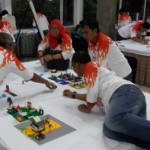Real Time Strategy for Teams
- This topic has 5 replies, 3 voices, and was last updated 9 years, 1 month ago by
 Gabriel.
Gabriel.
-
AuthorPosts
-
May 13, 2016 at 10:48 pm #7027
 GabrielParticipant
GabrielParticipantHello everyone,
I need advice on running a Real Time Strategy for Teams.
I was asked to facilitate a team building workshop composed mainly of 6 to 8 senior executives. The main issue is team dysfunction and lack of trust. The project sponsor would like to get its team to work more together and act as one.
My questions:
1) Can the complete Real Time Strategy for Teams be used in one day?
2) What subsets of the Real Time Strategy process is most critical if I only have 6 hours?
3) Besides Real Time Strategy, are there any other tools I can use for team building? I was thinking of the Trust Canvas by Alexey Pikulev.
4) What experiences can any of you share?Thank you.
Gabriel
May 14, 2016 at 6:47 am #7029 SebastianMember
SebastianMemberHi Gabriel,
re the Real time Strategy for Teams.. an alternative method to use is the The Five Dysfunctions of a Team. By Patrick Lencioni model.
Basically the exercise would be:LSP Skill building
Johari Window.. each participant builds:
1. their own perception of how they behave in a work team
2. how they perceive another person behaves in the work teamEach pax then shares their view of themselves and the other person (anonimously). (During this exercise someone needs to jot the characteristics on a flipchart. Alternatively each person has a check sheet that they fill in as the sharing is being done.
At the end all pax have to guess who the anonymous other person was.
DEBRIEF: Compare description of self and that built y someone else. It is rare that all the descriptions of own’s self main team behaviour characteristics match tha built by others. This dovetails into the fact that if you dont know your team member or his/her perspective on team behaviour then you have potential for team dysfunction. It is also fun and breaks the ice to go into the following exercise:The Five Dysfunctions of a Team. By Patrick Lencioni model – summary in : http://flpbs.fmhi.usf.edu/pdfs/Five%20Dysfunctions%20of%20a%20Team.pdf
The basic of this are that a team needs the following:
1. They trust one another.
2. They engage in unfiltered conflict around ideas.
3. They commit to decisions and plans of actions.
4. They hold one another accountable for delivering against those plans.
5. They focus on the achievement of collective results.EXERCISE:
Depending on time:
Accept the above 5 functions as ideal team identity / Behavior
– Each builds their perception of how the above would look like at work by building LEGO models.
– Share and combine into one model for each dysfunction/function
– Place each model in landscape mode on table .. spread out as five separate ideal objectives to aspire to.– Everyone starts building solutions/initiatives/actions that are within their power to implement in small LEGO models.
– Place each solution model on a line distance to each function ideal based on the AGREED IMPACT of each solution (High. Medium. Low).
– Share, Discuss and compromise on which main actions they should choose to implement to achieve the 5 Ideal Team Functionalities. Ideally do not choose more than 3 main actions (SGP).Alternatively the above step could just combine all 5 functions in 1 model if pressed fro time, but I find separating them makes for a clearer and uncluttered discussion.
At the end each person makes a personal commitment as to how he/she would personally implement the SGP at work and also critically HOW THEY WILL MONITOR AND MEASURE the implementation. I always use a short Survey Monkey on line survey on a 2 week/monthly basis to measure. Or make it a small part of their agenda at their monthly meetings.
You should be able to do this in a day
Hope this helps
Cheers
May 14, 2016 at 11:23 am #7032 Eli De FriendMember
Eli De FriendMemberHi Gabriel,
I recently ran a “Team-Building” Workshop for MSC Cruises with Tatiana Gavrilova and Joyce Miller. This was a mandate we got through the seriousplaypro web site, so we will be paying 10% of our fees back to seriousplaypro as a referral fee.Personally, I resent being asked to use LSP for “Team-Building”, because I maintain that “Team-Building” is “collateral damage” from the LSP process and is unavoidable; and so therefore the client should focus on something more complex and challenging. The customer chose to focus on diversity and HQ/subsidiaries as themes. We built these concepts into the groups, rather than designing questions around those themes. We were given a sneak preview of a presentation from HR on the subject of Corporate Values and decided to use that as the framework for the content of the later parts of the day.
We presented Tuckman’s Forming-Storming-Norming-Performing model as a lens/framework, but did not use it in the content of the workshop.
I think that if you have a whole day with people who are already working together, using Johari Window can be useful. We only had four hours and were working with people from Global Headquarters and from subsidiaries around the world, 30% of whom had only joined the organisation in the last 12 months and many of whom had never worked with each other. So Johari Window wasn’t going to work.Here are some of the challenges we used:
Pair Build: Ideal/Nightmare colleague
Individual Build: The Professional You in your current job, including what do you bring to the team?
Individual Build: Building for Success – what characteristics of YOU are critical to the success of the organisation?
Shared Build: Build a model of the strengths of the organisation, including elements of individual Professional YOU
Individual Build: Construct a model of one of the Corporate Values
Shared Landscaping the Values around the Strengths of the Organisation
Individual Build of Connections from Values to Strengths of the Organisation
Shared Build of Connections throughout the landscape
Individual Build: Factor which could influence the strengths of the organisationThat was as much as we could achieve in 4 hours.
We of course did include some story-telling and seat shifting at various points throughout the process, but those aspects are often dependent on the client context and the time available. We only had 4 hours.
All the best,
Eli
May 14, 2016 at 4:01 pm #7035 GabrielParticipant
GabrielParticipantHi Eli and Sebastian,
thank you very much for your respective inputs.
General question to both of you: when you designed your respective workshops, did you at any time mention to your client you were going to use LSP? In other words was was the selling argument? I still struggle with that part. I always use a solutions based approach and end up telling my clients I will use a special tool: LSP. But they seem reluctant. Then when I go into explaining why and the benefits, they generally say WOW! But still hesitate.
Sebastian: it’s funny that you mentioned Lencioni, I am actually reading his book as we speak. In fact the project sponsor has asked me to read it and see if I can build a workshop around it. I was not yet sure how to use LSP with it. But I guess I have the answer now! Can you tell me after this workshop, did you get a feel or sense that the team became closer? That they actually opened up to each other to show their vulnerabilities and their strengths, as Lencioni stated? How was the overall mood at the end?
Eli: I am not sure I understand what you mean by Pair Build… is it when two people work on one same model? In this case the nightmare colleague? Can you please elaborate? Also, I see that you used connections, I have not yet had the experience of going this far with a workshop. All the workshops I’ve conducted went to landscaping at most. How did the participants experience this part of the workshop? Was it complicated to make them understand? Also how many people were in this workshop?
Thank you so much for your inputs
Gabriel
May 14, 2016 at 7:32 pm #7036 Eli De FriendMember
Eli De FriendMemberHi Gabriel,
Answers:
Yes, a pair build is when two individuals build a single construction – a hybrid between individual and shared. You have the basic advantages of negotiation, while still maintaining a certain intimacy/privacy.Regarding connections, most participants are already doing it before we get to that formal step, so the answer to the question “Was it complicated to make them understand?” is No, not at all.
We had prepared for 45 participants but finally had about 38 with 3 facilitators, plus an assistant – definitely manageable.
All the best,
Eli
May 17, 2016 at 2:16 am #7042 GabrielParticipant
GabrielParticipantThanks Eli for all your input.
Gabriel
-
AuthorPosts
- You must be logged in to reply to this topic.

 Become a LEGO Serious Play facilitator - check one of the upcoming training events!
Become a LEGO Serious Play facilitator - check one of the upcoming training events!